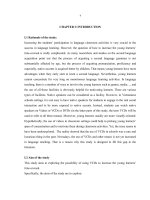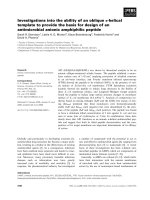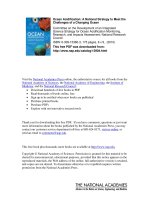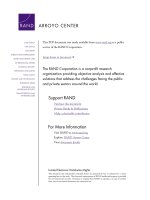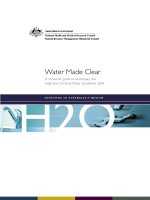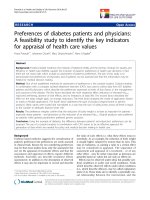TOWARDS a CONSISTENT CHRONOLOGY TO EXPLAIN THE EVOLUTION OF THE RIBOSOME
Bạn đang xem bản rút gọn của tài liệu. Xem và tải ngay bản đầy đủ của tài liệu tại đây (26.62 MB, 199 trang )
!
TOWARDS A CONSISTENT CHRONOLOGY
TO EXPLAIN THE EVOLUTION OF THE
RIBOSOME
!
!
ZHANG BO
(B.SCI.,USTC)
A THESIS SUBMITTED
FOR THE DEGREE OF DOCTOR OF PHILOSOPHY
IN COMPUTATION & SYSTEMS BIOLOGY (CSB)
SINGAPORE-MIT ALLIANCE
NATIONAL UNIVERSITY OF SINGAPORE
2012
!
!
II!
DECLARATION
I hereby declare that this thesis is my original work and it
has been written by me in its entirety.
I have duly acknowledged all the sources of information
which have been used in the thesis.
This thesis has also not been submitted for any degree in
any university previously
____________________
ZHANG BO
24
th
Aug. 2012
!
Zhang Bo
Digitally signed by Zhang Bo
DN: cn=Zhang Bo, o, ou,
email=, c=US
Date: 2013.06.06 21:28:21 +08'00'
!
!
III!
Acknowledgements
It was not possible for me to realize the great support I have gotten
from my friends and family until I finished my thesis and looked back over the
journey past. They have helped and continually supported me along this long
and fulfilling road.
I would like to express my great thanks to my PhD supervisor,
Professor Christopher W. V. Hogue, who is not only a mentor but also a dear
friend. Throughout the four years study, I have been confused and lost my
directions. I could not reach where I am today without his inspirational,
supportive, kind and patient guidance, and editorial assistance in preparing this
thesis.
Many thanks go to my MIT-Singapore program co-advisor, Professor
Gil Alterovitz, who provided encouraging and instructive comments about my
projects and showed me great kindness when I was studying in MIT.
A good support system is important in surviving and staying in
graduate school. I am very grateful to my department, Singapore-MIT
Alliance, for providing me four years Graduate Scholarship financial
assistance. I am also grateful to our co-chair, Professor Gong Zhiyuan and
former co-chair, Professor Hew Choy Leong and the staff and students in
SMA, especially in Computation & Systems Biology.
I also have to thank the members of my PhD committee and my
examiners for their helpful advice and suggestions in general.
I am so lucky to have been surrounded by wonderful colleagues. I will
take this opportunity to thank all my workmates and lab mates who have
!
!
IV!
contributed to such a pleasant environment for the past four years: Shweta
Ramdas who contributed to this project in her honors year; Zhao Chen, a
wonderful friend; Liao Xuanhao who provided a great help in the wet lab and
all my lab mates. I am sincerely grateful that I have this group of passionate
people to work with in Hogue’s lab. I could always ask for advice and help.
And Kootala Parasuraman Sowmya, our secretary, is always there for us.
Also essential to my thesis were the software and applications,
especially the Design Structure Matrix software developed by Loomeo. I will
also thank a group of experts who helped keep my thesis real. They have given
me the permission to include their beautiful and accurate figures in my thesis.
I especially thank my mom and dad. They have sacrificed so much in
their lives for my comfortable life and provided me unconditional love and
care. I would not make this real without their support. I truly thank Li Qiushi
for always standing by my side and sharing my dreams.
!
!
!
V!
Table of Contents
Acknowledgements III!
Table of Contents V!
Summary VII!
List of Figures IX!
List of Tables XI!
Introduction 1!Chapter 1
1.1!Background!and!Significance! !5!
1.1.1!Ribosomal!Structure!and!Function! !6!
1.1.2!The!RNA!World!Theory!and!Other!Origin!Hypotheses! !15!
1.1.3!Hydrothermal!Vents! !22!
1.1.4!Current!Research!on!the!Evolutionary!Timeline!of!the!Ribosome! !26!
1.2!Objectives!and!Proposed!Solutions! !52!
1.2.1!Objectives!and!Specific!Aims! !52!
1.2.2!Research!Scope! !56!
Material and Methods 58!Chapter 2
2.1!Chronology!Models!for!E.#coli!Ribosome! !58!
2.1.1!Preparation!for!the!Chronology!Models! !58!
2.1.2!The!Chronology!Models! !60!
2.2!Chronology!Models!for!the!E.#coli!Ribosome!Q!DSM! !65!
2.2.1!Design!Structure!Matrix!(DSM)! !65!
2.2.2!Domain!Mapping!Matrix!(DMM)! !70!
2.3!Visualization!of!the!Ribosomal!Evolution!Chronology! !71!
2.3.1!Video!of!Hydrothermal!Vent! !72!
2.3.2!Animation!of!Molecular!Structures! !73!
2.3.3!Animation!of!Molecular!Structures!Q!Software! !74!
2.4!Simplest!ProtoQRibosome! !75!
2.5!Overview!of!Joint!DSM!Model!Development!Approach! !76!
Chronological Evolution of E. coli Ribosomal LSU 84!Chapter 3
3.1!DSM!Chronology!Models!for!LSU! !84!
!
!
VI!
3.1.1!“ProteinsQearliest”!Model! !85!
3.1.2!Hybrid!Model! !96!
3.1.3!Discussion!of!the!Optimal!and!SubQOptimal!Paths! !100!
3.2!PolypeptidylQTransferase!Center!(PTC)! !103!
3.3!Theory!in!the!Ribosomal!Evolution!between!Archaea!and!Bacteria! !106!
3.4!Discussion!for!the!Evolutionary!Model!of!LSU! !111!
Chronological Evolution of E. coli Ribosomal SSU 117!Chapter 4
4.1!Preliminary!Data!for!SSU! !117!
4.1.1!AQminor!Interactions! !118!
4.1.2!ProteinQProtein!Interactions! !120!
4.2!Banded!Chronology!DSMs!Model!of!the!SSU! !122!
4.3!Discussion!of!the!Banded!DSM!Model!of!the!SSU! !129!
Chronological Evolution of the E. coli Ribosome 136!Chapter 5
5.1!InterQSubunit!Interface! !136!
5.2!Joint!Chronology!of!the!SSU!and!LSU! !138!
5.3!Discussion!of!the!Joint!Chronology!of!the!E.#coli!Ribosome! !149!
Animation of the Ribosomal Evolution 152!Chapter 6
6.1!Visualization!of!the!Joint!Chronology!Model! !152!
6.2!Hydrothermal!Vent!System!Background! !157!
6.3!Animation!of!the!Joint!Chronology!of!the!Ribosome! !158!
6.4!Discussion!of!the!Animation!Process! !158!
The Structure of the Simplest Proto-Ribosome 161!Chapter 7
7.1!Three!Cores! !161!
7.2!Discussion!of!the!Proposed!r29QPTC!ProtoQRibosome!Model! !167!
Conclusion and Future Research 169!Chapter 8
Bibliography 173!
Appendices 186!
!
!
VII!
Summary
The ribosome comprises the structure and mechanism for the
translation of nucleic acid gene sequences into proteins in all living creatures.
The large subunit (LSU) of the ribosome is reducible to an ancient catalytic
core peptidyl-transferase structure (PTC) (Agmon, Bashan et al. 2005). A
model of hierarchical addition of E. coli 23S (where ‘S’ refers to the
Sedimentation Coefficient) rRNA modular inserts (HIM) was proposed
(Bokov and Steinberg 2009) explaining how inserts led from the PTC to the
full ribosome. Based on this information, a detailed chronology of the
ribosome was developed, including rRNA modules and ribosomal proteins (r-
proteins) in the large and small subunits (SSU) of E. coli using the Design
Structure Matrix (DSM), and employing dependencies from 3D structure and
topology. The DSM does not use sequence information, yet the results are
remarkably well validated against other models of ribosomal evolution. The
earliest period of structure accumulation is better fitted to a protein-free
assembly than a protein-early model. For the first two proteins appearing in
the chronology, L22c is the beta-strand protrusion of L22 and L32 binds via a
bare alpha helix next to L22c in a crevice proximal to the polypeptide exit
tunnel. These are congruent with a theory that the first proteins were simple
units of secondary structure, prior to the evolution of folded forms. A feedback
loop from these two crevices may provide selective pressure for fixation of
initially random sequences for stronger binding forms that may have
streamlined nascent peptide exit. Such feedback could have helped fix the
earliest portion of the genetic code. While there is no L32 in the archaea, part
!
!
VIII!
of the space occupied by L32 was found filled with a structure arising from a
sequence insert into archaeal L22 that may have displaced L32 from the
archaeal ribosome. Decomposition of the SSU 3D structure into rRNA module
inserts reveals two originating cores labeled r23 and r29. The r29 module is
consistent with a functional form of the earliest proto-SSU and its structure
validated by a new reduced mitochondrial SSU sequence. A banded DSM
chronology shows how the SSU may have evolved in stages from these two
core structures. The interface between the LSU and SSU together with the 5S
fragment and all r-proteins were combined together into a final DSM of the
entire E. coli ribosome, which was iteratively refined by constructing full
animations of the chronology in the Maya software package. Docking supports
a potential functional form of the earliest proto-ribosome comprising the PTC
and r29, suggesting that the SSU and LSU co-evolved from the start. The
chronology supports a transition from mini-tRNA to full-tRNA upon the
build-up of the subunit interface, a period congruent with the fixation of the
genetic code, and a last common ribosomal ancestor structure before the split
of archaea and bacteria. With the 2D and 3D illustrations of the evolutionary
process presenting the ribosomal chronology, the results represent the most
complete story of ribosomal evolution so far presented.
!
!
!
IX!
List of Figures
Figure 1.1 Structure of intact E. coli 70S ribosome. 11!
Figure 1.2 Ribosome architecture in prokaryotes and eukaryotes. 12!
Figure 1.3 Overview of the bacterial translation. 13!
Figure 1.4 Timeline of evolution. 18!
Figure 1.5 RNA reactor from a hydrothermal vent pore network. 24!
Figure 1.6 Evolutionary transition of mini-tRNA to full-length tRNA. 32!
Figure 1.7 The symmetrial RNA dimer structures of PTC. 44!
Figure 1.8 Hierarchical model of the LSU from Bokov and Steinberg. 47!
Figure 1.9 Secondary and tertiary structure of the SSU. 48!
Figure 1.10 Onion-like model. 50!
Figure 2.1 A brief introduction to the Design Structure Matrix (DSM). 67!
Figure 2.2 LOOMEO SSU input structures. 68!
Figure 2.3 Domain Mapping Matrix structures in the LOOMEO. 70!
Figure 2.4 Domain mapping graph. 71!
Figure 2.5 Project DSM analysis stages. 77!
Figure 3.1 Interaction networks. 84!
Figure 3.2 Domain Mapping Matrix for the LSU. 88!
Figure 3.3 DSM of modules and proteins insertion order. 89!
Figure 3.4 Hybrid model DSM and “proteins-earliest” model DSM. 95!
Figure 3.5 LSU secondary structure and interaction schematic representation
of the hybrid model DSM chronology. 99!
Figure 3.6 Half-point distance trend. 104!
Figure 3.7 Positions of the PTC and rRNA modules in the LSU. 105!
!
!
X!
Figure 3.8 Secondary structure of HM. 107!
Figure 3.9 Ribbon structure of HM 50S subunit 108!
Figure 3.10 Comparison of L22. 110!
Figure 4.1 Example of the four types of the A-minor interactions. 118!
Figure 4.2 A-minor interactions in 16S rRNA. 120!
Figure 4.3 Interaction networks. 121!
Figure 4.4 Example of contacts comprising SSU r-protein interactions between
S14 and S10. 122!
Figure 4.5 Banded DSM model of SSU dependencies from E. coli. 125!
Figure 4.6 Secondary structure schematic illustrating chronology of SSU
rRNA modules and proteins. 128!
Figure 4.7 Secondary structures in M. leidyi mt-rRNAs. 132!
Figure 5.1 Intersubunit bridges of the E. coli ribosome. 137!
Figure 5.2 DSM chronology of the entire E. coli ribosome. 140!
Figure 5.3 Adjusted Final Joint chronology 144!
Figure 5.4 Domain mapping graph of the two subunits. 146!
Figure 6.1 Top view of the 3D ribosomal surface structure using Autodesk
Maya. 152!
Figure 6.2 Animation frames of insertion steps and chronological milestones. . 156!
Figure 6.3 Hydrothermal vent model. 157!
Figure 6.4 Movie capture. 158!
Figure 7.1 Docking trials of r29 and PTC. 165!
Figure 7.2 Model of proposed r29-PTC proto-ribosome system. 166!
!
!
XI!
List of Tables
Table 1.1 Ribosomal composition 10!
Table 3.1 “proteins-early modules” and “protein-free modules (B&S)” 93!
!
!
1!
Introduction Chapter 1
The ribosome serves as the protein production machinery of the cell,
carrying out the process of translating nucleotide sequences into nascent
proteins with remarkable speed and accuracy in all living creatures. It has
attracted the attention of researchers since the mid-twentieth century (Moore
2009). The ribosome is composed of two subunits, both comprising RNAs and
proteins. The larger subunit contains the functional core, the peptidyl-
transferase center (PTC), and binds to the transfer RNA (tRNA) and the amino
acids. The smaller subunit, which binds to the messenger RNA (mRNA),
works as the decoding center in the translational process. Despite the
remarkable size differences across the three domains of life, bacteria, archaea
and eukaryote, it has been demonstrated that the decoding center and the PTC,
composed solely of ribosomal RNAs (rRNA) are the core functional region of
ribosome, and highly conserved in nucleotide sequence and bound ribosomal
protein sequences (Belousoff, Davidovich et al. 2010). Owing to the
fundamental importance of protein synthesis for all living creatures, it is
generally accepted that the accumulated ribosomal complex is a molecular
witness to the origin of life. A variety of evidence suggests that the earliest
origin of the ribosome is likely to lie in an RNA world and the common
components of the ribosome complex were present during period of the last
universal common ancestor (Babb, De Luca et al. 1988). The majority of
genes common to the LUCA model are associated with translation (Fox 2010).
The path of ribosome through evolutionary time has left it with sequence
!
!
2!
variation, which offers great utility in the reconstruction of phylogenetic
relationships (Woese, Kandler et al. 1990). However, few geological clues
exist that date back to the origin of ribosomal protein synthesis approximately
four billion years ago, making the period of origin difficult to study.
To understand the evolution of the ribosomes, the relative age of the
multiple ribosomal proteins and specific regions within the rRNAs can be
considered as markers of evolutionary timing events. The core of the ribosome
comprises the conserved mechanism for the translation of nucleic acid gene
sequences into proteins in all living creatures. The PTC, which is embedded in
the center of the LSU, is proposed as the ancestral form of the ribosome
(Agmon 2009). However, comparative evidence is likely to favor the theory
that the sequence of the ribosomal SSU rRNA is closer to the ancestral version
(Woese, Gutell et al. 1983). The debate over which subunit came first has been
ongoing, and there has been a continued interest in the evolutionary history of
the ribosomes for decades. Numerous analyses have tried to figure out the
origin and development of the effective translation machineries among the
three domains of life utilizing a variety of methods, such as crystallographic
studies (Yusupov, Yusupova et al. 2001), comparative sequence and structure
analysis (Cannone, Subramanian et al. 2002), and amino acid usage biases
identification (Fournier and Gogarten 2010). The result of this interest is
substantial, and there now exist a wide range of sequence alignments and
high-resolution 3D structures of functional molecules relating to translation
and of the entire ribosome itself. However, there is not any clear evidence of
the chronological path that led from the beginning structure to the modern
ribosome, and there continues to be ongoing debate about this project.
!
!
3!
Therefore, it is imperative to find convincing and credible techniques to
reconstruct the evolutionary rRNA gene and the ribosomal protein
accumulation process, in order to expose the most plausible evolutionary
origin and to present a defensible chronology process of the ribosome, as it
emerged from the RNA world to the LUCA and further into the three domains
of life.
It is noteworthy that the steady development of the biochemical and
biophysical techniques has triggered a more detailed study into the ribosomal
evolution, supplementing rRNA and ribosomal protein sequences with high-
resolution three-dimensional structures, and the functional interactions of the
ribosomal complex with external molecules. Evidence relating to the
ribosomal evolution and its essential role in the translation and other cellular
processes continues to emerge, which further simulates the establishment of
detailed ribosomal phylogenetic trees and chronology models among the three
domains of life.
This thesis presents the application of an analysis tool commonly used
in the field of engineering, called the Design Structure Matrix (DSM), to
construct a plausible and detailed evolutional chronology of the 3D structure
of the E. coli ribosome, together with a detailed consideration of the
environmental factors that may explain how protein synthesis emerged based
on the numerous clues embedded in the ribosomal structures. The DSM is an
engineering method for scheduling complex systems in systems analysis and
project management. It lists all constituent tasks with the corresponding
information exchange and dependency patterns, or it can be used to
decompose a complex system based on its topology and connectivity into a
!
!
4!
stepwise assembly process. It uses a square matrix of dependencies and has
been adapted to numerous engineering applications. DSMs can be built from
lists of tasks or from information based on interfaces between software
components, i.e. nested function call dependencies. A DSM is populated with
dependency information and then sorted into order from least to most
dependent, which then can be interpreted as a schedule for part or component
design tasks, or assembly instructions, or as a means to simplify software
development. Very often DSMs are incomplete and expose a series of
equivalent sub-optimal schedules, any which may be equally considered.
Despite not having a single unique solution, the number of possible schedules
can be dramatically reduced and DSMs can shed some light on alternative
solutions.
The DSM has been widely used in over a thousand papers in
engineering research and industry for solving complex problems and
managing complex structures such as aircraft design process (Xu, Song et al.
2011), systems evolving prediction (Josko 2012) and production line
development (Maki 2012). There are many examples of the DSM method’s
application to resolving the optimal order of assembly events from
dependencies based on object connectivity. Given the depth of this existing
DSM literature (as listed on www.dsmweb.org) the approach has been
extremely well validated with man-made objects with physical, electrical or
software complexity. However, the DSM approach has not been used
previously to study any biological systems, but as this thesis will demonstrate,
affords a remarkable view on the chronology of the ribosome. The DSM
methodology should prove useful and provide information about a wide
!
!
5!
number of other evolutionary problems outside of the ribosome where
currently phylogenetic trees are the only available chronological view.
In order to understand the evidence and dependencies used in the DSM
analysis and the resulting chronology of ribosome evolution, subsequent
sections of this chapter provide an overview of the research history of the
ribosome and the factors influencing the studies of the ribosomal evolution as
well as the origin of life. This is followed by a discussion of the research aims
and an overview of the proposed solutions. A detailed description of the
methodology and research workflow used in this study is provided in Chapter
2.
1.1 Background and Significance
It is generally accepted that the ribosome emerged in the so-called
‘RNA world’ when proteins did not exist and the primordial chemical
reactions of life were catalyzed by some prebiotic chemistry forming
nucleotides and RNA. The ribosome is a molecular witness to the endpoint of
the ‘RNA world’ period as it comprises the conserved mechanism for the
translation of nucleic acid gene sequences into proteins in all living creatures.
It may also be possible that the early ribosome, called the proto-ribosome, was
present and influential in the early stages of the RNA world according to the
“helicase hypothesis” (Zenkin 2012) that posits that the necessary base pairing
of RNA strands in the RNA world required enzymatic separation and that a
proto-ribosome may have fulfilled that function.
Few geological clues exist that date back to the origin of ribosomal
protein synthesis approximately four billion years ago, making the period of
origin difficult to study (Gesteland, Cech et al. 2006). Submarine
!
!
6!
hydrothermal vents have been proposed as a potential location for the origin of
life and a great deal has been recently learned about their structure and unique
chemical environment. Researchers have provided evidence from underwater
scenes with stunning views of the giant white carbonate chimneys of
submarine hydrothermal vent fields. It is believed that the serpentinite-hosted
ecosystem within these vents, in which geological, chemical, and biological
processes are intimately interlinked, can lead to fascinating insights about the
nature of early life on earth.
Next in this chapter, a brief introduction of the ribosomal structure and
function is provided in Section 1.1.1, as well as a full discussion of the
concept of the “RNA world” and a summary of the various origin-of-life
hypotheses in Section 1.1.2. The discovery of the hydrothermal vent system
and their implications on the environmental location of the prebiotic and early
biotic chemistry is discussed in Section 1.1.3, which is followed by the
description of the research history of ribosome in Section 1.1.4.
1.1.1 Ribosomal Structure and Function
The ribosome is a large complex molecule made from non-covalently
bound RNAs and proteins, responsible for decoding genetic information
encoded in messenger RNAs (mRNA) and catalyzing the peptide bond
formation into proteins in all living cells (Korostelev 2011). In this section,
both the structure information and correlated function are discussed.
1.1.1.1 High-Resolution Ribosomal Structures
In view of the development of the molecular biological research, the
discovery of the ribosome and the successful elucidation of its role in protein
!
!
7!
synthesis and gene expression was one of the biggest achievements in 1950s
and ‘60s (Moore and Steitz 2002). The ribosome was first observed in the
mid-1950s by George Emil Palade using an electron microscope and the term
“ribosome” was proposed by Richard B. Roberts in 1958 (Roberts 1958). Ever
since then, the structure and function of the ribosome and its constituent
molecules have been very active fields of study. In the early experiments,
results demonstrated that ribosomes typically contain 50 to 60 percent RNA
(Noller 1984) in the integral structures, which surprised nearly everyone as
ribosomes work as enzymes, catalyzing protein synthesis. It is intriguing to
understand the contribution that RNA makes to the ribosomal function and by
the late 1980s; the discovery of numerous ribozymes further simulated the
interest in RNA-based catalysis in the biochemical and molecular biology field.
However, the shortage of accurate 3D structural information left much
uncertainty in the ribosome field (Moore 2009). Ribosome reconstitution
experiments demonstrated how the constituent parts of the ribosome
assembled together (Kurland 1977), and the conserved operon structure of the
bacterial and archaeal ribosomal structures was elucidated (Itoh, Takemoto et
al. 1999) and demonstrated to be connected to the temporal order of ribosome
assembly.
By 1988, X-ray crystallography and electron microscopy were the two
promising approaches for solving the ribosomal structure. Nobel Prize winner
Ada Yonath was the first to crystallize intact ribosomes in 1984 (Yonath 1984),
however, the crystal quality obtained from ribosomes and ribosomal subunits
and the resolutions of the diffraction patterns would be the limiting factor in
obtaining three-dimensional data for another decade. By interpreting the X-ray
!
!
8!
diffraction patterns determined by the experiments, the electron distribution of
the atoms can be used to compute the crystal structures, which are the three-
dimensional models of molecules. However, the crystallography of very large
macromolecules, like the ribosome, depends on both having a good diffraction
pattern and on having phase data from heavy atom substitution. The phase
problem for the ribosome remained a challenge, which was much more of a
limiting problem than crystal quality, for almost ten years until a Cryo-EM
reconstruction of the ribosome was used to phase the diffraction pattern by
using molecular replacement. This led to the first 9 Å resolution density map
of the ribosomal large subunit (Moore 2002) and thereafter, ribosome
crystallography advanced rapidly (Moore 2009) leading to the high-quality
structures we have today.
The ribosomal structures became clear in 2000, with the first complete
atomic structure of the large ribosomal subunit from Haloarcula marismortui
at 2.4 Å resolution (Ban, Nissen et al. 2000) and the small subunit of Thermus
thermopihlus (Brimacombe 2000; Harms, Schluenzen et al. 2001). This was
the first breakthrough in the understanding of the relationship between
ribosomal structures and functions. Since 2000, multiple high-resolution,
three-dimensional structures from archaeal and bacterial species have been
obtained, which has dramatically advanced our understanding of the ribosome.
Among these atomic resolution ribosomal structures, three structures appeared
to be the founder structures that are defined as the first atomic resolution
structures from particular ribosome crystals achieved in a particular laboratory
(Moore 2009). First, a high-resolution structure of the large ribosomal subunit
from the bacterium Deinococcus radiodurans was reported by the Yonath
!
!
9!
group (Harms, Schluenzen et al. 2001). Second, the 70S ribosome structures
of the archaeon Thermus thermophilus that were determined up to 5.5 Å by
two independent groups, Noller’s group and Ramakrishnan’s group (Yusupov,
Yusupova et al. 2001; Korostelev, Trakhanov et al. 2006; Selmer, Dunham et
al. 2006) and third, a structure of the 70S ribosome at 3.5 Å from Escherichia
coli. (Schuwirth, Borovinskaya et al. 2005) Besides these founder structures,
there were numerous crystal structures of ribosomes in complexes with
various substrates, substrates analogs and factors (Moore 2009). The 2009
Nobel Prize in Chemistry was awarded to Venkatraman Ramakrishnan,
Thomas A. Steitz and Ada E. Yonath for their role in elucidating the crystal
structure of the ribosome and its role in the development and understanding of
the mechanisms of bacterial ribosome-binding natural product antibiotics.
Although ribosomes from bacteria, archaea and eukaryotes are
responsible for protein synthesis, several significant differences in the
structures and RNA sequences between bacterial and archaeal ribosomes, and
even more differences are seen between these and the larger eukaryotic
ribosomes. Mitochondrial ribosomes also have significant differences in
structure owing to various evolutionary branches exposed to reductive
evolutionary pressure, often losing RNA structure and gaining new protein
substituents. By using Cryo-EM, the structural information has also been
investigated among various functional complexes (Taylor, Nilsson et al. 2007;
Becker, Bhushan et al. 2009). These studies have supplied important
information for the understanding of ribosomal structures and functions.
Recently, the published crystal structure of the Tetrahymena thermophila 40S
ribosomal subunit (Rabl, Leibundgut et al. 2011) and 3.0 Å high-resolution
!
!
10!
structure of the 80S ribosome from the yeast Saccharomyces cerevisiae (Ben-
Shem, Garreau de Loubresse et al. 2011) will pave the way for the further
genetic, structural and functional studies as well as the more recent structural
comparison between the prokaryotes and eukaryotes (Klinge, Voigts-
Hoffmann et al. 2012).
1.1.1.2 The Basic Architecture of the Ribosomes
As the crystal structures and the complementary electron microscopic
(EM) reconstructions of the ribosomes have been deposited into the ribosomal
structure databases, our understanding of the essential molecular translational
machine have dramatically increased.
Table 1.1 Ribosomal composition
!
!
Prokaryotes!(70S)!
50S!LSU/30S!SSU!
Eukaryotes!(80S)!
60S!LSU/40S!SSU!
LSU!proteins!
31!proteins!
46!proteins!
!!!!!!!!RNAs!!!!!
23S/15S!RNAs!
28S/5S/5.8S!RNAs!
SSU!proteins!
21!proteins!
33!proteins!
!!!!!!!!RNAs!!!!!
16S!RNA!
18S!RNA!
The ribosome, which is made from complexes of RNAs and proteins,
is divided into two subunits, each comprised RNA and proteins (Table 1.1). In
bacteria, the large subunit (LSU) is called the 50S subunit, which contains the
23S ribosomal RNA (rRNA), 5S rRNA and 30 proteins; the small subunit
(SSU) is called the 30S subunit, which contains the 16S rRNA and 21 proteins
(Figure 1.1). The interface between the two subunits mainly consists of rRNA.
The smaller subunit binds to the mRNA through the cleft between the ‘head’
and ‘body’, while the larger subunit binds to the tRNA and the amino acids.
!
!
11!
There are three tRNA binding sites. The A site binds to the aminoacyl-tRNA,
the P site holds the peptidyl-tRNA with the nascent polypeptide chain, while
the deacylated P-site tRNA ejected through the E site after peptide-bond
formation (Schmeing and Ramakrishnan 2009). When a ribosome finishes
reading an mRNA these two subunits split apart. Although the ribosome
contains dozens of proteins, it is the ribosomal RNA that plays the most
important part in its two major functions—the selection of the proper amino
acid and the transpeptidation reaction itself (Bokov and Steinberg 2009).
!
Figure 1.1 Structure of intact E. coli 70S ribosome.
Two subunits are included with specific annotations. Light blue: 16S rRNA; dark
blue: 30S proteins; grey: 23S rRNA; magenta: 50S proteins; L1: protein L1/rRNA
arm; ASF: A-site finger; CP: central protuberance; L11: protein L11/rRNA arm; E:
free tRNA exit site; P: peptidyl-tRNA binding site; A: aminoacyl-tRNA binding site.
(Schuwirth, Borovinskaya et al. 2005) (Reprinted with permission from AAAS,
copyright 2005)
Compared to bacterial and archaeal ribosomes, eukaryotic ribosomes
are approximately 30% larger than the bacterial counterparts (Klinge, Voigts-
Hoffmann et al. 2012) (Figure 1.2), but share a common substructure.
Eukaryotic ribosomes also contain two subunits, the small (40S) subunit and
large (60S) subunit, which consists of four rRNAs (18S, 25S, 5.8S and 5S)
and 79 core conserved proteins across yeast to humans (Venema and
Tollervey 1999). Although the core architectures of the prokaryotic and
!
!
12!
eukaryotic ribosomes are conserved, several additional proteins and new
rRNA elements appear in the eukaryotic ribosomes, with important changes in
the two subunits. Eukaryotic ribosome synthesis largely takes place both in the
cell cytoplasm and a specialized nuclear compartment, the nucleolus. The
transcription of rRNA from rDNA genes and most of the maturation process,
including base modification, happens in the nucleolus. This
compartmentalization is quite different from bacterial cells, where synthesis
takes place in the cytoplasm.
!
Figure 1.2 Ribosome architecture in prokaryotes and eukaryotes. !
(a, b) Top views of the heads from Thermus thermophilus 30S subunit (PDB code
2j00) (Selmer, Dunham et al. 2006) and Tetrahymena thermophila 40S subunit (PDB
code 2xzm) (Rabl, Leibundgut et al. 2011) (c, d) Architectures of the T. thermophilus
50S subunit (PDB code 2j01) (Selmer, Dunham et al. 2006) and T. thermophila 60S
subunit (PDB codes 4A17 and 4A19) (Klinge, Voigts-Hoffmann et al. 2011)
Conserved proteins have the same colors. (Klinge, Voigts-Hoffmann et al. 2012)
(Reprinted with permission from Elsevier, copyright 2012)!
!
!
13!
1.1.1.3 Ribosomal Functions
Since the publishing of the high-resolution structures of ribosomal
subunits in 2000, crystallography and electron microscopy have facilitated the
interpretation and determination of the interaction between the structures and
functions of the ribosome. In translation, the ribosome decodes the
information carried by mRNA and then produces a specific amino acid chain,
which subsequently folds into an active protein. This section mainly focuses
on the translational mechanism of the bacterial ribosomes, which happens in
the cell’s cytoplasm. Generally, bacterial translation can be divided into three
phases, initiation, elongation and termination (Figure 1.3).
!
Figure 1.3 Overview of the bacterial translation.
aa-tRNA, aminoacyl-tRNA; EF elongation factor; IF, initiation factor; RF, release
factor. (Schmeing and Ramakrishnan 2009) (Reprinted with permission from
Macmillan Publishers Ltd: Nature, copyright 2009)
Initiation of translation requires the selection of an initiation site
(usually AUG) of mRNA, where the specialized initiator tRNA, fMet-
tRNA
fMet
, is positioned. By base pairing between the 3’ end of 16S rRNA and
!
!
14!
the complementary sequence upstream the mRNA start codon (Shine-
Dalgarno sequence), the initiation complex forms with the help of three
initiation factors (IF1, IF2, IF3) and the initiation codon is placed at P site of
the ribosome.
In the elongation cycle, amino acids are sequentially adding to the
polypeptide chain until they reach a stop codon on the mRNA. During
decoding, the new aminoacyl-tRNA is delivered with the help of elongation
factor-Tu (EF-Tu) to the A site, where correct aminoacyl-tRNA is selected via
GTP hydrolysis. After the correct binding of the new aminoacyl-tRNA,
peptide bond formation, the central chemical event in protein synthesis, takes
place. This is catalyzed by a region of 23S rRNA of the ribosomal large
subunit, located at the bottom of a large cleft (Nissen, Hansen et al. 2000).
After peptide bond formation, the growing polypeptide is attached to the new
amino acid from the A-site tRNA leaving a deacylated P-site tRNA. Following
the binding of the GTPase elongation factor G (EF-G), the mRNA shifts by
precisely one codon and the tRNAs translocate with respect to the 30S subunit
via a rotation of the tRNA molecule from A to P site (Joseph 2003).
When an mRNA stop codon moves into the A site, termination occurs.
The terminal signal is recognized by the class I release factors (RF1 or RF2),
which cleaves the nascent polypeptide chain and releases the newly
synthesized protein from the ribosome. After that, the class II release factors
(RF3) triggers the dissociation of class I factors, leaving mRNA and a
deacylated tRNA in the P site. Next, ribosome recycling factor (RRF) carries
out the recycling of ribosome together with EF-G. The ribosome is split into
subunits, preparing for another round of protein synthesis.
